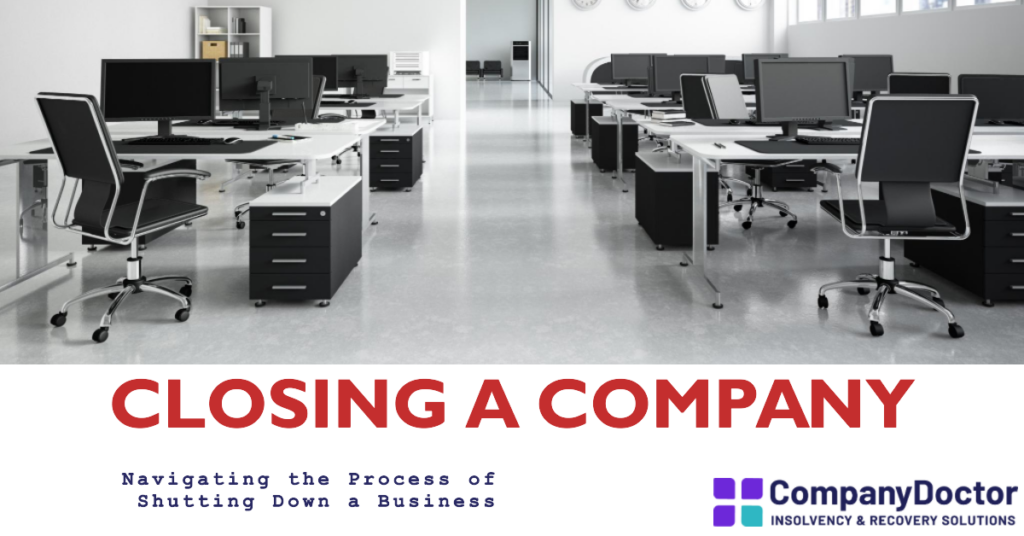Understanding the process of closing a company is crucial. It’s not as simple as just shutting your doors and walking away. There are legal obligations to meet, financial matters to settle, and in some cases, staff and creditors to consider. The process can be intricate, and failing to do it correctly can lead to legal complications and financial liabilities.
This guide aims to shed light on the secrets of closing a company, providing you with a comprehensive understanding of the process. We’ll delve into the steps involved, the financial aspects to consider, and the legal requirements you need to meet. Whether you’re a director of a limited company considering your options or simply seeking to broaden your business knowledge, this guide is for you.
Quick Links
What is a Limited Company?
A limited company is a type of business structure where the company has its own legal identity separate from its owners (shareholders) and its managers (directors). This means the company itself can own assets, enter into contracts, and is responsible for its own debts.
One of the main characteristics of a limited company is the limited liability of its members. This means that the personal financial risk for shareholders is limited to the amount they have invested in the company, protecting personal assets from business debts.
Company directors are the individuals responsible for running the company. They make the strategic and operational decisions and are responsible for ensuring the company meets its legal obligations. This includes everything from filing annual accounts to ensuring the company operates within the law.
Reasons for Closing a Company
There are various reasons why a company might need to be closed. It could be due to retirement, a change in the business environment, financial difficulties, or even a strategic decision to focus on other ventures.
It’s important to understand the difference between a solvent and insolvent company when considering closure. A solvent company is one that can pay its debts when they are due. If a company is solvent, the directors may apply to strike off the company or start a members’ voluntary liquidation. On the other hand, an insolvent company is one that cannot pay its debts. In this case, the options are creditors’ voluntary liquidation, compulsory liquidation, or administration.
Understanding the reasons for closing a company and the state of the company’s finances is the first step in navigating the process of company closure.
Freephone including all mobiles
The Process of Closing a Company
Voluntary Strike Off and Dissolution
Voluntary strike off and dissolution is a process where the directors of a company choose to remove the company from the Companies House register. This effectively ends the existence of the company. It’s a relatively straightforward and cost-effective method of closing a company, but it’s only suitable for companies that have ceased trading and have no outstanding debts or legal disputes.
The steps to take for striking off and dissolving a company according to GOV.UK guidelines are as follows:
Liquidation Process
Liquidation is the process of winding up a company and distributing its assets. It’s a more complex process than striking off and is typically used when a company has debts it cannot pay. There are two main types of liquidation: voluntary and compulsory. Voluntary liquidation is initiated by the directors, while compulsory liquidation is initiated by the creditors.
Dealing with Company Debts
When closing a company, it’s important to deal with any outstanding debts. This can involve negotiating with creditors, selling assets to pay debts, or entering into an insolvency procedure. In many cases, the services of a licensed insolvency practitioner will be required to handle the dissolution process and strike a deal with creditors. They can provide advice on the best course of action and handle the insolvency process on behalf of the company.

Financial Aspects of Closing a Company
Understanding Capital Gains and Taxes
Capital gains refer to the increase in value of an asset or investment over time. When you sell an asset for more than you paid for it, the profit is considered a capital gain. For businesses, this can include property, equipment, or even the business itself.
When closing a company, it’s important to consider the tax implications of dissolution and strike. In the UK, companies are subject to Corporation Tax on their profits, including capital gains (known as ‘chargeable gains’ for Corporation Tax purposes). This means that if the company sells assets and makes a profit, it may need to pay tax on this.
However, there are reliefs and allowances that can reduce the Corporation Tax on chargeable gains. For example, Entrepreneurs’ Relief (now known as Business Asset Disposal Relief) may be available if you’re selling all or part of your business.
It’s also important to remember that the company needs to file a final Company Tax Return and pay any outstanding Corporation Tax. This includes tax on income and gains made in the accounting period up to the date the company is struck off.
Dealing with Company Assets
When closing a company, you’ll also need to deal with the company’s assets. This includes tangible assets like property and equipment, and intangible assets like intellectual property and goodwill.
If the company is solvent, assets can be sold and the proceeds distributed to shareholders. If the company is insolvent, assets may need to be sold to pay off creditors. In some cases, assets can be distributed ‘in specie’ to shareholders. This means the assets are transferred to the shareholders rather than being sold and the proceeds distributed.
The process of dealing with assets can be complex, particularly if the company has significant assets or is insolvent. It’s often advisable to seek professional advice to ensure assets are dealt with correctly and legally.
After Closure
Post-Closure Responsibilities
Even after a company has been closed, there are still responsibilities that the company directors need to fulfill. These responsibilities primarily involve dealing with the company’s final accounts and records, and ensuring that the company is properly removed from the Companies House register.
Here is a sequence diagram illustrating the post-closure responsibilities:
In summary, the director needs to notify Companies House of the company’s closure. Companies House will then remove the company from the register. The director is also required to keep the company’s records for seven years after closure.
Getting Help with Closing a Company
When to Seek Professional Help
Closing a company can be a complex process, particularly if the company is insolvent or has significant assets. In these cases, it can be beneficial to seek professional help.
Licensed insolvency practitioners are professionals who are authorised to act in relation to an insolvent company or individual. They can provide advice on the best course of action, help with the process of liquidation, and ensure that all legal requirements are met.
How Company Doctor Can Assist with Company Closure
If you’re considering closing your company and need assistance, Company Doctor can help. As licensed insolvency practitioners based in Leeds, we offer advice and solutions to directors struggling with insolvent companies. We provide Creditors’ Voluntary Liquidations, a process that allows you to voluntarily bring your company to an end and ensure your creditors are treated fairly.
Our team is experienced in dealing with all aspects of company closure, from striking off and dissolution to dealing with company debts and assets. We can guide you through the process, ensuring that everything is handled correctly and legally.
If you need help with closing your company, don’t hesitate to contact us. You can reach us at 0800 169 1536 or leave an enquiry on our website. We’re here to help you navigate this challenging process.
FAQs
What is the difference between striking off and liquidation?
Striking off is a process where a company is removed from the Companies House register and ceases to exist. This is typically used for dormant or non-trading companies that have no outstanding debts. Liquidation, on the other hand, involves selling off a company’s assets to pay off its debts before it is dissolved.
Can a company be restored after it has been dissolved?
Yes, a dissolved company can be restored to the Companies House register if an application is made to the court. This is typically done if the company was struck off by mistake, or if it needs to be restored to bring a legal claim.
What happens to the company’s assets when it is closed?
When a company is closed, its assets are typically sold off to pay any outstanding debts. Any remaining assets are then distributed among the shareholders.
What are the responsibilities of a company director when closing a company?
The director is responsible for ensuring that all the company’s debts are paid off, its assets are dealt with, and its final accounts are prepared. They must also notify Companies House of the company’s closure and keep the company’s records for seven years after closure.
Can I close a company with outstanding debts?
Yes, but the process is more complex. If a company has outstanding debts, it will typically need to go through a process of liquidation. This involves selling off the company’s assets to pay its debts. If the company is insolvent, it may need to enter into a formal insolvency procedure, such as administration or Creditors Voluntary Liquidation (CVL).
Conclusion
Closing a company is a significant decision and involves a complex process that requires careful planning and execution. Whether it’s understanding the basics of a limited company, navigating the process of voluntary strike off, dissolution, or liquidation, dealing with company debts and assets, or fulfilling post-closure responsibilities, each step requires careful consideration and understanding.
Remember, it’s not a process you have to go through alone. Licensed insolvency practitioners like Company Doctor are here to help. We can provide the advice and assistance you need to ensure the process is handled correctly and legally, helping to alleviate some of the stress and uncertainty that can come with closing a company.
Whether your company is solvent or insolvent, whether you’re ready to move on to new ventures or you’re facing financial difficulties, don’t hesitate to seek professional help. It’s a crucial step that can make the process of closing your company smoother and more manageable.
Need Help with Closing Your Company? Contact Company Doctor Today!
Closing a company can be a complex and daunting process, but you don’t have to navigate it alone. At Company Doctor, we specialize in providing advice and solutions to directors of struggling companies. As licensed insolvency practitioners based in Leeds, we have the expertise and experience to guide you through every step of the process.
Whether your company is solvent or insolvent, we can help. Our services include assisting with Creditors’ Voluntary Liquidations, a process that allows you to voluntarily bring your company to an end while ensuring your creditors are treated fairly. We can also provide advice on dealing with company debts and assets, striking off and dissolution, and post-closure responsibilities.
Don’t let the process of closing your company overwhelm you. Let Company Doctor provide the support and guidance you need. Contact us today at 0800 169 1536 or leave an enquiry on our website. We’re here to help you navigate the process of closing your company with confidence and peace of mind.
References
The primary sources for this article are listed below.
Running a limited company – GOV.UK (www.gov.uk)
Details of our standards for producing accurate, unbiased content can be found in our editorial policy here.

